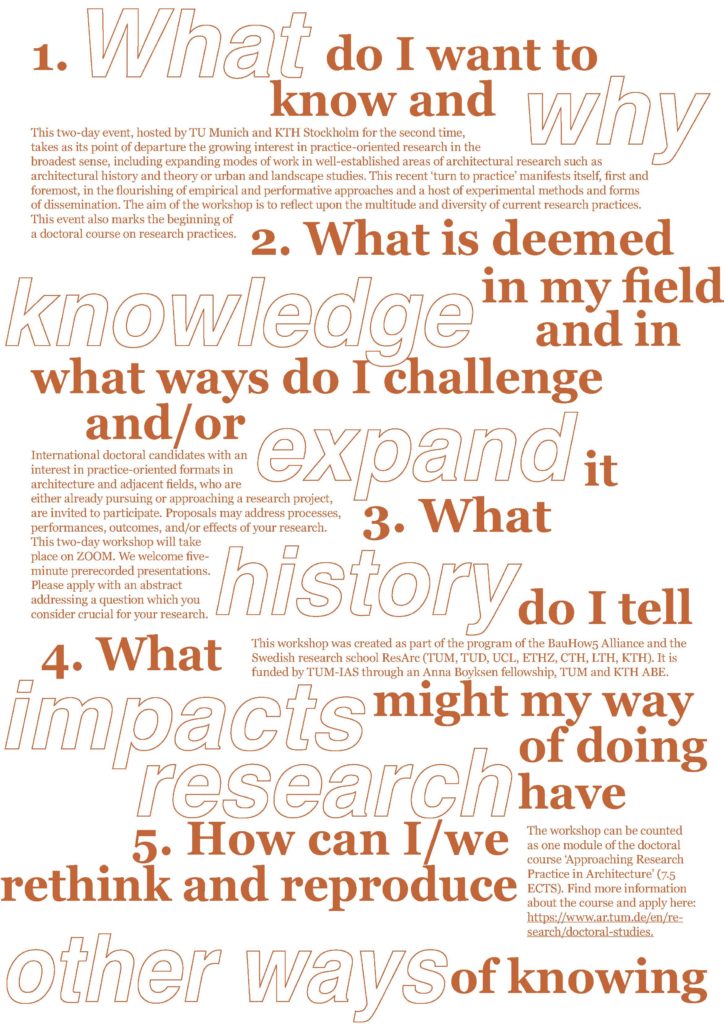Brief thoughts after participating in a doctoral workshop organized and hosted by the BauHOW5

This week I had the opportunity to participate in a doctoral workshop on architectural research held online and hosted by members of the BauHOW5 consortium – TU Munich (DE), TU Delft (NE), UCL – The Bartlett (UK), Chalmers University (SE), and ETH Zurich (CH). The workshop, “Approaching Research Practice in Architecture,” focused on questions of knowledge in architectural research, and included a series of addresses and short five-minute presentations by current doctoral candidates from institutions within and beyond the consortium. I, myself, presented my research-in-progress as a doctoral candidate at the University of Glasgow.
As a whole, the workshop was interesting and instructive, with a fairly broad variety of research being presented and discussed. I was particularly drawn to the more practice-oriented research being pursued, and it was useful to see how doctoral candidates were working on (re)drawings of material histories (Asha Sumra, Aarhus School of Architecture) and living practices on threatened coastlines (Zihao Wong, University of Singapore), or the qualitative spatialities of kitsch (Elisa Monaci, Sapienza University of Rome). I was also glad to see that nearly all of the projects presented — perhaps this is the BauHOW5 effect? — take positions that can be at least nominally considered as politically engaged, and mostly seek to ameliorate not only our built environments, but also the broader sense of living spaces as we are finally understanding them now, as well as those meant for non-human beings. This includes panels on the second day — “Resist, reclaim, contest, conceptualize, decolonize” and “Experiments and histories for a broken planet” — but could also be found in work oriented towards digital practices, collective planning, and building for care, among others.
Heal the world by building?
I have a good friend and fellow doctoral candidate who, as an architect, has been frustrated and doubtful about the tendency among certain people to seek to solve the world’s problems with architecture, not only contributing to the constant subjugation of architecture to other concerns, but also often showing a rather superficial understanding of those concerns themselves. We might call this the “We’re gonna fix this sad bad neighborhood with a funky bench” attitude among do-gooder architects. I understand my friend’s frustration and critique, and I think it is important to step back from privileged conventions of engagement, altruism and militancy. An entity doesn’t have to be the Gates Foundation to help reinforce and reproduce the very structures it claims to be opposing. At the same time, I’m relieved to see such a broad series of attempts to do better. When I compare the work of my doctoral colleagues with the work of architects still seeking to make the next beautiful architectural object, I can’t help but feel there is reason to hope.
Other reasons were embodied by the guest speakers to the conference, including an opening address from Lilian Chee (University of Singapore) which challenged architectural conceptions of domestic space, and a presentation on Counterspace by Amina Kaskar. This latter presentation, in particular, struck me in its discussion of soft architecture in South Africa, and particular its thinking through the socio-spatial workings of fabric, and which of course brought to mind Lisa Robertson’s terrific work in/as The Office of Soft Architecture, not to mention Lisa’s abiding and fascinating thinking about fabric. Otherwise, I have not yet seen Esra Akcan’s presentation, “Methodology as Ethics,” as I’m drawing up these notes just beforehand, but I’m very much looking forward to it.
Text as project material: Presenting my work in a hospitable research context
As for my own participation, I was very happy to be able to present my doctoral research in a panel on “Knowledge and Media,” chaired by Karin Reisinger of the Academy of Fine Arts in Vienna, Austria. Fellow panelists discussed disentangling the layers of invisibility in the built environment of Tokyo (Anne Gross – Tokyo Institute of Technology), deploying narrative design tools in the museum design (Tom Duncan – University of Leicester), dramatization and spatialization of relationships as visible in certain poetics of encounter (Leo Xian – ESALA), and questions of language and insularity in architecture (Helka Dzsacsovski – TU Munich). It really was a pleasure to be among these fellow panelists, in particular for the ways in which nearly everyone’s presentation showed layers of reflection that — in my eyes — called into question common understandings of representation in architecture and spatial design in general, understandings in which it is taken for granted that architecture is something other than the representations we use to think through it. This gave me the opportunity to speak about text/language as architectural materials, as well as the role of incarnation and/or materialization of spatial projects in different forms (I’ll forgo the idea of media, at least for now), and exchange fruitfully with several colleagues.
I suppose the obvious (!) conclusion is that such workshops are designed with exactly this in mind, that by sharing our work-in-progress, we find points in common and are able to open new dialogues with colleagues. For that I am grateful to the organizers from the BauHOW5, as well as all the participants (with particular thanks to Asha Sumra who pointed me towards a terrific digital archive related to the Architecture School of Valparaíso and the Open City). The experience was very different than that of when I presented at the University of Glasgow Creative Writing Symposium, in particular since that occasion was mostly attended by members of my home institution. Being confronted with other ways of understanding doctoral research, particularly where this difference is culturally inflected, has give me good means of rethinking certain aspects of my research. This leaves me a fair amount of work to do, however, and so it’s time to get back to the floor! Among other things, I need to keep thinking about a “standard feminist question” posed by Karin Reisinger and which I hope to keep as a guide: Who is this knowledge for?